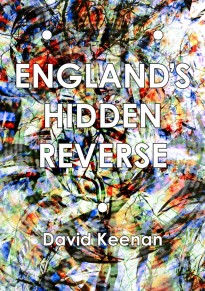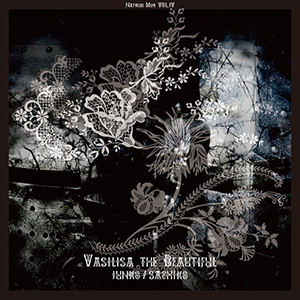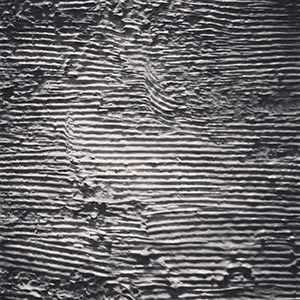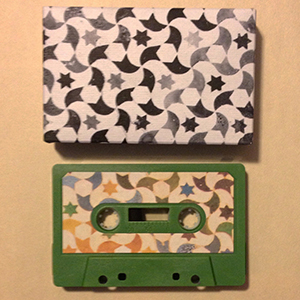- Administrator
- Albums and Singles
Also, ex-VTB member Nick Mott has a great new CD released on Lumberton Trading Company. The album is called 'Here Begins The Great Destroyer'.
Read More
- Administrator
- Albums and Singles
After a string of Natural Snow Buildings reissues, each more elaborate (um, longer) then the last, Ba Da Bing presents our first ever release of NEW material from the band. For a group known for its use of horror imagery and lyricism, perhaps the most shocking thing of all is that this album clocks in at just under 45 minutes. If there ever was an album that served as the proper entry point for Natural Snow Buildings, Terror's Horns is it.
It would be a stretch to call this Mehdi Ameziane and Solange Gularte's pop record, for Terror's Horns continues in the duo's tradition of combining many layers into sometimes blissful, sometimes contemplative, often menacing conditions. Stringed instruments trill, percussion gongs, feedback hisses and vocals maintain near monotone as if in a cultish trance. The songs still pride themselves on a slow development, and the album's progression lends the impression of descending down through the depths, past hidden cavities and chambers that you will never unsee once experienced. Featuring new artwork by Gularte which pays tribute to the backwoods horror of massacres involving chainsaws.
More information can be found here.
Read More
- Administrator
- Albums and Singles
The end of 2013 saw the reformation of one of the most revered and respected late '80s UK alternative bands, LOOP. The group, founded by Robert Hampson, hadn't played together since the early '90s, but got together to curate a night at the legendary All Tomorrow's Parties at Camber Sands. US dates followed in 2014 and they then got back in the studio to start recording. The result is three brand new releases coming over the next year which see the band return to their hugely unique and era-defining sound whilst sounding fresh and exciting.
The first release is Array 1, four tracks and 32 mins of haunting, aggressive, beautiful noise. "Precession," "Aphelion," "Coma" and "Radial" are the first songs to be heard from their recording session done in Sub Station Studios in Rosyth in Scotland with the current line-up of Robert Hampson (vocals/guitar), Hugo Morgan (bass), Wayne Maskell (drums) and Dan Boyd (guitar). With only an early version of "Precession" having had any previous outing (at a show at the Garage in London at the end of 2014), this is the very first new music from the band since their third album, 1990’s lost classic A Gilded Eternity.
The next tracks will be released in the autumn in keeping with Loop's previous habit of putting out music in batches: Hampson describes it as "one project, with the same concept, delivered in bulletins."
More information can be found here.

Read More
- Administrator
- Albums and Singles

England's Hidden Reverse: A Secret History of the Esoteric Underground
by David Keenan
Revised & expanded edition
336 pages, hardback/paperback, 210mm x 148mm
Fully illustrated in colour.
* Full colour throughout
* Two new chapters and a significant number of new images
* Cover by Mark Titchner
Hardcover edition also includes:
FURFUR:
120-page A5 zine with all new, exclusive interviews and imagery from more provocateurs of the EHR universe: including Alex Binnie, Antal Nemeth, Chris Carter, Colin Potter, Cosey Fanni Tutti, Drew McDowall, Ivan Pavlov, Jill Westwood, Jordi Valls, Matthew Levi Stevens, Paul Hurst and Christine Glover of Produktion, Robin Rimbaud and more TBC.
More information can be found here.
Read More
- Administrator
- Albums and Singles

With a quiet intensity over the last 12 years, Strategy has proven himself to be an incredibly resourceful and rewarding musician in both group settings and as a solo artist. In the latter guise, this Portland producer/multi-instrumentalist (aka Paul Dickow) has released a prolific amount of excellent work for quality indie labels such as Kranky, Orac, 100% Silk, Endless Flight, and Entr'acte, putting a cerebral yet sensual spin on dub, ambient, post rock, and house music.
For his Further Records debut, Noise Tape Self, Strategy delves ever deeper into his more ambient inclinations and experiments with tape loops. Most of the six tracks bear titles more suited for a library record, but Noise Tape Self lacks library music's faceless functionality; rather, it's an immersive soundtrack to stimulating one's imagination or losing one's bearings. Dickow says he became obsessed with making tape music in 2008, after tiring of using the computer as his main instrument. Fellow Portland producer/ingenious gear-tinkerer David Chandler (Solenoid) taught Dickow “how to make a tape loop that could be put inside a cassette tape. I got really into this, and got a 4 track, knowing this would allow me to have four synchronized loops per tape. I would then run each channel through a series of effects and 'perform' live mixes using the loops. I alternated between using source material of my own devising and using whatever source material happened to be on the cassettes I was hacking.”
Noise Tape Self kicks off with "Awesome Piano," in which a fragment of a beautiful piano motif gets overwhelmed by a glorious vortex of static and distortion. We're immediately submerged in Strategy's alluring and disorienting world, where rupture and rapture converge. "Cassette Loop" is a gorgeous ambient piece with a lulling, aquatic quality that recalls such masters of uneasy listening as Rapoon, O Yuki Conjugate, and Aube. The self-descriptive "Ominous Lovely Piano" is a ghostly, microcosmic form of dub, an ultimate kind of headphone music of deep psychedelic interiority that's reminiscent of Paul Schütze's 1996 masterpiece, Apart. The hypnotic/amniotic ambience of "Lovely Loop" whispers of a peaceful eternity; this track could be an important step toward a new, improved strain of New Age. The album closes with "Rhen's Loop"; here's where the album really soars into the stratosphere and grows surreal wings. A five-dimensional headfuck of what sounds like analog-synth growls and whirs and desolate drones, "Rhen's Loop" is Doppler-effected and disorienting, like a more somber take on Conrad Schnitzler's Ballet Statique. With Noise Tape Self, Strategy has found a way to build works of compelling, intimate grandeur with some of the humblest of sonic atoms. It's an alchemical wonder.
More information can be found here.
Read More
- Administrator
- Albums and Singles

A record of slowly evolving beauty that gradually unravels its meditative design. Recorded in Norwegian sculptor and painter Emanuel Vigeland' s (1875 -1948) mausoleum in Oslo in 2013. A recording space that is famous for its acoustics and its long and full-sounding reverb. These three tracks utilize both the delicacy and the power of acoustic instruments and human voice in relation to the unique recording space. This is a record that is otherworldly and eerie but also with a great primal expressive force. Performed by four artists from different backgrounds coming together to create this singular set of music.
- Beneath The Bough (13:03)
- The Green Flood (18:57)
- Afterglow (30:31)
Maja S.K. Ratkje - Voice and Bells
Jon Wesseltoft - Accordion Organ and Harmonium
Camille Norment - Glass Armonica
Per Gisle Galåen - Zither and Harmonium
More information can be found here.
Read More
- Administrator
- Albums and Singles
 Initially I was not sure what to expect from this pairing. I know Sachiko's solo work can be a varying mix of beauty and ugly, and Junko via Hijokaidan, which is always intensely, yet brilliantly abrasive. On Vasilisa the Beautiful, harshness is the clear winner. Two vocal performances of raw throated dissonance over a bed of electronics, recorded live, makes for anything but an easy album to listen to.
Initially I was not sure what to expect from this pairing. I know Sachiko's solo work can be a varying mix of beauty and ugly, and Junko via Hijokaidan, which is always intensely, yet brilliantly abrasive. On Vasilisa the Beautiful, harshness is the clear winner. Two vocal performances of raw throated dissonance over a bed of electronics, recorded live, makes for anything but an easy album to listen to.
Right from the opening moments the duo are on attack.Shrill vocals, mostly dry from Junko and treated from Sachiko, are brought up loud in the mix.Behind the voice is a guttural passage of electronics, unspecific in their origin but trudging along like a dying animal.The vocals shift from harsh screams to babbling noise, all the while the background noise grinds away harshly.
While the vocals stay rather consistent, the electronics are dynamic, shifting register and character.At times the backing sounds like a broken synthesizer, at others a heavily distorted guitar.When the noise is at its most dense, and the vocals firmly locked into screaming mode, I definitely felt parallels with the early/mid 1990s era of Hijokaidan.
Towards the middle of the piece the background shifts into a great, churning mechanical noise din, before transforming into a massive locust swarm buzz.With a great balance between the electronics and the voice, which has become a cracking, dry throated serrated knife.Dive-bombing tones and ringing electronics continue relentlessly, keeping everything harsh.
In its closing minutes, the electronics go even darker and more bleak, as the vocals finally scale back, ending the piece with what sounds like processed and treated dialog, rather than the non-stop screaming that preceded it.Make no mistake; Vasilisa the Beautiful is a difficult album.Anyone familiar with Junko's performances with Hijokaidan should know exactly what to expect.Just like that material, however, there are times where this sort of unabashed chaos and dissonance is simply the perfect album.
samples:
 
Read More
- Administrator
- Albums and Singles
 With these two near-simultaneous releases, Joao Da Silva's Luciernaga takes two different approaches to his not quite noise, not quite musical. To the Centre of the City in the Night is the more fleshed out release, with its five pieces running the gamut from bowed string drones to harsher electronics. Tile II, a follow up to the similarly titled release from last year is more immediate, which is fitting a super-limited tape and free digital release. They are two sides of the same coin, with both being enthralling in their own ways.
With these two near-simultaneous releases, Joao Da Silva's Luciernaga takes two different approaches to his not quite noise, not quite musical. To the Centre of the City in the Night is the more fleshed out release, with its five pieces running the gamut from bowed string drones to harsher electronics. Tile II, a follow up to the similarly titled release from last year is more immediate, which is fitting a super-limited tape and free digital release. They are two sides of the same coin, with both being enthralling in their own ways.
Invisible City Records/Idle Chatter
To the Centre is the more album-like of these two releases, in that it feels as if these pieces were more carefully constructed and composed over a longer period of time.Using only synth, guitar, and his voice, Da Silva creates dynamic and multi-layered pieces that are constructed and deconstructed throughout."A Blue Light" features droning tones paired with shimmering electronics and a hint of noise.There is a progression from purer sounds at the beginning into fragmented and decaying passages towards its end.There was a hint of darkness to that piece, but "Sleeping Green-Eyed Girl" is almost all-peaceful beauty.Loops and beautiful drones make for a dynamic song, but in a calm and placid mood.Even though it is heavily drawn from from electronic sources, it has an extensively organic sound, resembling a living and breathing organism.
The other half of To the Centre is a darker affair.Deep synth and squalling guitar set a darker, menacing mood to "Cold was the Night".With all its scraping and gliding noises, it is the sonic equivalent of a serpent slithering through metal wreckage and barbed wire.The lengthy "Elevated" might not be quite as sinister, but is no less intense.A more hypnotic, loop heavy piece with messy outbursts to keep the sound from becoming too stagnant, Da Silva uses the extended duration to build the piece and allow a bit of light to shine through the otherwise dark haze.
 Tile II, on the other hand, comes together as a more immediate, almost improvised sounding work in that the pieces are more sparse, but also have their own minimalist charm.The chiming singing bowl that opens "Mourning Raga", mixed with a harmonium-like drone has a simple, yet meditative quality to it.The two part "Serpentine" sees Da Silva emphasizing clean guitar over what sounds like a slowly changing and evolving loop.The mix may be simple, but the sound is extremely complex.The second part uses a more primal guitar sound that adds dissonance to the overall sound.Like its predecessor, the second side of the tape is a single loop played for nearly 15 minutes with enough complexity to be hypnotic without being overly repetitive.
Tile II, on the other hand, comes together as a more immediate, almost improvised sounding work in that the pieces are more sparse, but also have their own minimalist charm.The chiming singing bowl that opens "Mourning Raga", mixed with a harmonium-like drone has a simple, yet meditative quality to it.The two part "Serpentine" sees Da Silva emphasizing clean guitar over what sounds like a slowly changing and evolving loop.The mix may be simple, but the sound is extremely complex.The second part uses a more primal guitar sound that adds dissonance to the overall sound.Like its predecessor, the second side of the tape is a single loop played for nearly 15 minutes with enough complexity to be hypnotic without being overly repetitive.
Both sides of the Luciernaga sound captured on these tapes complement each other extremely well, and I could not choose one as superior to the other.The more composed sound of To the Centre captivates with the constantly shifting mix and varying dynamic, with each listen revealing an additional layer of depth.At the same time, Tile II’s minimalist, almost live sound has a distinct purity and clarity that hits all the right buttons.Either way, both are exceptional and Da Silva is an artist who continues to impress me with each new release I hear.
samples:
 
Read More
- Administrator
- Albums and Singles

September 2015 will see the release of Thighpaulsandra's 7th full length album The Golden Communion, his first since 2006's The Lepore Extrusion. Well over a decade in the making, this is his debut for Editions Mego. It comprises 10 new songs, running well over two hours with individual pieces clocking in between 4 and 28 minutes. Featured musicians on the album include regular collaborators Martin Schellard and Sion Orgon, plus the odd guest/ghost from bands Thighpaulsandra has worked with in the past.
If you have heard any of Thighpaulsandra's previous albums, you will know that you'd best approach this record with no fixed set of expectations, because once again he changes genres and defies easy classification, sometimes more than once within one song. Drawing on his long-time background as a key member in such diverse groups as Coil, Spiritualized and Julian Cope's band (in each case arguably at the height of their creative prowess) and his work as producer and sound engineer for an even larger variety of customers, you'll find classical passages next to hard rock riffing, krauty experimental work-outs turning into super catchy, almost radio-friendly songs and more.
Many adjectives have been used to describe Thighpaulsandra’s work: epic, challenging, timeless, idiosyncratic, but certainly never predictable or boring.
Possibly his most rewarding album yet and a welcome and unusual entry, in the Mego catalogue, which will entertain and astonish listeners who are fond of having their mind severely altered by sound.
More information can be found here.
Read More
- Administrator
- Albums and Singles

Produced by Kieran Hebden between August 2014 and February 2015
This music was created on a laptop computer using the Ableton Live software to control and mix VST synthesizers and manipulations of found audio recordings.
Slightly more information can be found here.
Read More
- Administrator
- Albums and Singles

Sirens is the first collaborative LP of Kara-Lis Coverdale (Tim Hecker, L/B) and LXV (David Sutton). Following their respective solo cassette releases Aftertouches (2015) and Spectral Playmate (2014) on Sacred Phrases, Coverdale and LXV debut on Umor Rex with a collection of multi-textural and multi-source electronic music rich in narrative, melody, and spectral intrigue.
Inspired by the link between seduction and violence, Sirens comprises a series of timbrally vast anamorphic pieces that poise the voice as a newly imagined tool of multiplicity. Processes of sample manipulation, signal processing, routing, and source design inform instrumental writing and performance in feedback until intertwined, flickering between states of conflict and consonance. Apparitions of the schitzophrenic voice are at one moment fractured and cold and at the next full of warmth and vivaciousness, embodying velvet rituals of romanticism in the digital age.
Ultimately, Sirens is music for ambitious dreamers: surreal sound portraits sound like the warmth of the world laid over an ice cold virtual altar. LXV’s vocal truncations and fleshy sound palettes depict the archivation of the breath and aural fantasies of the flesh which Coverdale sets amongst a vast and unconfined landscape of deeper and unknown force. Harmonically active and dynamic orchestrations underpin post-sacred tonalities while brooding pipe organs, sphinx flutes, and hailstorms of metallic percussion characterize uniquely disjointed discussions between disparate compositional ontologies. At times violent and at others serenely peaceful and seductive, these pieces, at their most powerful moments illuminate a felt space between cybernetic energy and the body.
More information can be found here.
Read More